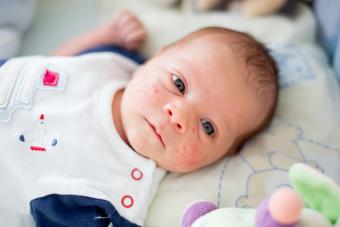
It is difficult to determine conclusively if stress causes petechiae. While there is a connection between stress and common rashes such as hives, there does not appear to be that same link to stress and petechiae.
What Is Petechiae?
Petechiae appear when small blood vessels break and superficial bleeding occurs under the skin. Tiny, red, pinpoint dots develop that may cluster and have the appearance of a rash. The tiny hemorrhages are usually flat to the touch and remain beneath the skin. While they are generally red in color, they can also be:
- Red-blue
- Purplish
- Brown
Whether it appears as a few small spots or a larger cluster of spots, petechiae most commonly appear on ankles or feet. However, it can appear on any area of the limbs, torso or face. Other common names for this skin condition include:
- Petechiae rash
- Petechial skin rash
- Purpuric rash which is bleeding under the skin in a larger, flat area
One way to determine if a rash is petechiae is by applying pressure to the area. If pressing on the skin does not turn the area lighter, or whitish, the spots are petechiae.
Causes of Petechiae

There are many known causes of petechiae ranging from coughing to life-threatening illnesses or conditions. Examples of the more common causes of petechiae include:
- Localized injury or trauma
- Diseases of the autoimmune system
- Allergic reactions
- Very high levels of blood platelets, known as thrombocythemia
- Infections affecting the blood's ability to clot
- Leukemia
- Malignancies of the bone marrow that cause very low blood platelet numbers
- Sepsis or other infections of the bloodstream
- Henoch-Schonlein Purpura - also known as HSP
- Idiopathic Thrombocytopenic Purpura - also known as ITP
- Chemotherapy
- Radiation treatments
- Violent coughing or vomiting
- Viral infections such as some types of influenza and enteroviruses
- Drugs and medications that are anticoagulants
Petechiae in High Velocity Injuries
A specific type of petechiae, known as stress linear petechiae, occurs when there is high velocity impact to the skin. According to Oski's Pediatrics: Principles & Practice by Julia A. McMillan, Ralph D. Feigin, Catherine DeAngelis and M. Douglas Jones, this type of petechiae rash is common in cases of child abuse. It occurs when a child is forcefully hit with an open hand. The impact of the slap on the child's skin leaves a clear outline of petechiae spots of the fingers and hand of the person that struck the child. A petechiae outline typically forms with any injury caused by a high velocity force.
Children With Petechiae and a Fever
In many cases of children with petechiae, the cause is never fully determined. Often the tiny spots appear on the face after a significant bout of coughing, vomiting or crying and disappear after a short time. However, if a child has a fever with petechiae, take the child to a doctor right away as it could be a sign of a bacterial infection in the bloodstream.

Questionable Connection Between Stress and Petechiae
There are people who feel their outbreaks of petechiae are more frequent or worse when they are dealing with severe or chronic stress. Although there is no medical evidence to support this, stress does affect every system and organ in the body in many different ways. Stress can also trigger other types of skin rashes such as stress related hives and possibly cherry angiomas.
The Importance of Reducing Your Stress Levels
Whether or not stress causes petechiae, learning to reduce your stress levels is important to your overall health. Taking the time to learn stress reduction methods such as meditation, deep breathing techniques or progressive muscle relaxation may reduce your stress levels. However, simple activities like taking a walk, listening to relaxing music or playing with your pet can also have a positive effect on your well-being.







